Biermann Ch. Handbook of Pulping and Papermaking
Подождите немного. Документ загружается.

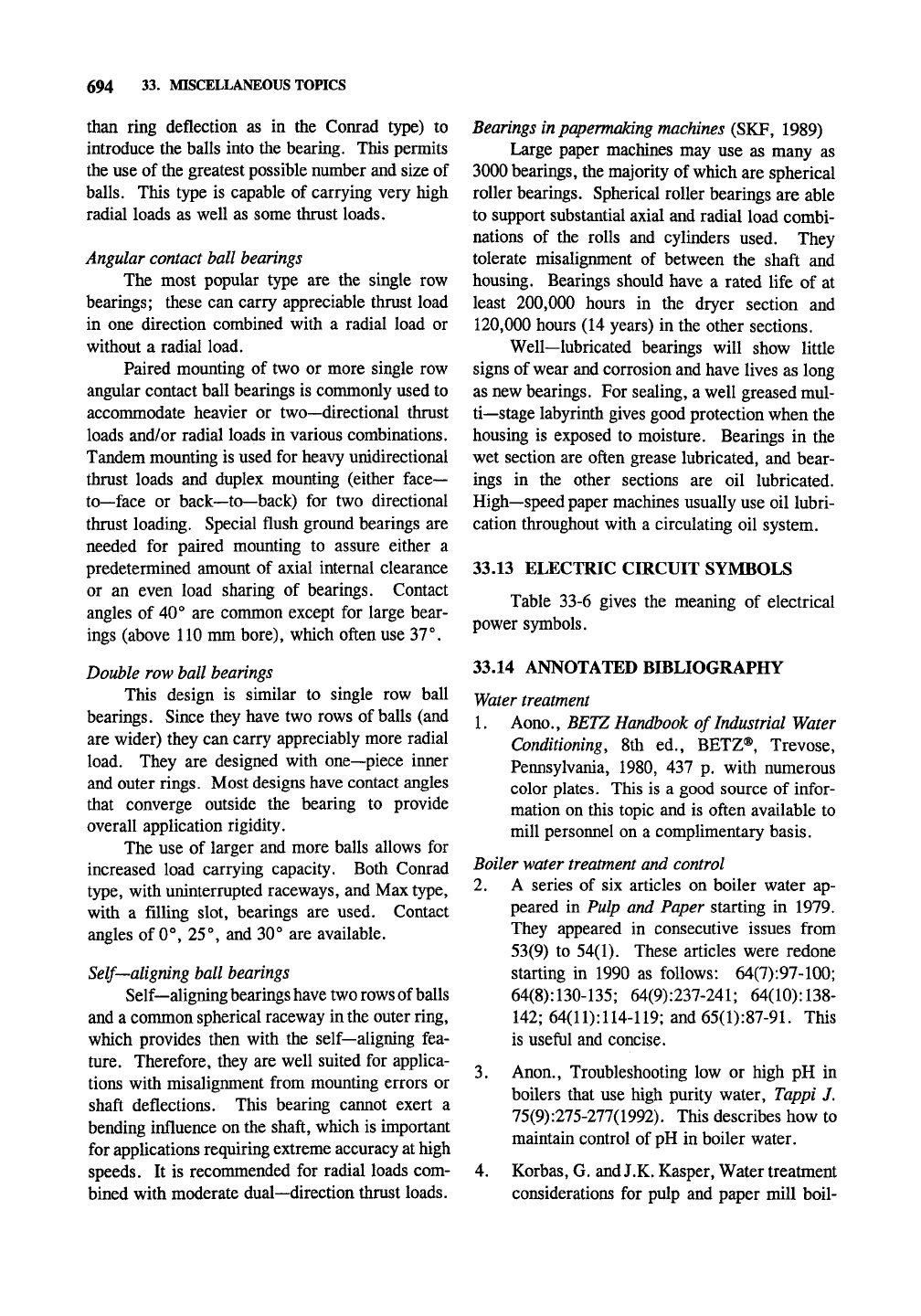
694 33. MISCELLANEOUS TOPICS
than ring deflection as in the Conrad type) to
introduce the balls into the bearing. This permits
the use of the greatest possible number and size of
balls.
This type is capable of carrying very high
radial loads as well as some thrust loads.
Angular contact ball bearings
The most popular type are the single row
bearings; these can carry appreciable thrust load
in one direction combined with a radial load or
without a radial load.
Paired mounting of two or more single row
angular contact ball bearings is commonly used to
accommodate heavier or two—directional thrust
loads and/or radial loads in various combinations.
Tandem mounting is used for heavy unidirectional
thrust loads and duplex mounting (either face-
to—face or back—to—back) for two directional
thrust loading. Special flush ground bearings are
needed for paired mounting to assure either a
predetermined amount of axial internal clearance
or an even load sharing of bearings. Contact
angles of 40° are common except for large bear-
ings (above 110 nmi bore), which often use 37°.
Double row ball bearings
This design is similar to single row ball
bearings. Since they have two rows of balls (and
are wider) they can carry appreciably more radial
load. They are designed with one—piece inner
and outer rings. Most designs have contact angles
that converge outside the bearing to provide
overall application rigidity.
The use of larger and more balls allows for
increased load carrying capacity. Both Conrad
type,
with uninterrupted raceways, and Max type,
with a filling slot, bearings are used. Contact
angles of 0°, 25°, and 30° are available.
Self—aligning ball bearings
Self—aligning bearings
have
two
rows
of balls
and a common spherical raceway in the outer ring,
which provides then with the self—aligning fea-
ture.
Therefore, they are well suited for applica-
tions with misalignment from mounting errors or
shaft deflections. This bearing cannot exert a
bending influence on the shaft, which is important
for applications requiring extreme accuracy at high
speeds. It is recommended for radial loads com-
bined with moderate dual—direction thrust loads.
Bearings in
papermaking
machines (SKF, 1989)
Large paper machines may use as many as
3000 bearings, the majority of which are spherical
roller bearings. Spherical roller bearings are able
to support substantial axial and radial load combi-
nations of the rolls and cylinders used. They
tolerate misalignment of between the shaft and
housing. Bearings should have a rated life of at
least 200,000 hours in the dryer section and
120,000 hours (14 years) in the other sections.
Well—lubricated bearings will show little
signs of wear and corrosion and have lives as long
as new bearings. For sealing, a well greased mul-
ti-stage labyrinth gives good protection when the
housing is exposed to moisture. Bearings in the
wet section are often grease lubricated, and bear-
ings in the other sections are oil lubricated.
High—speed paper machines usually use oil lubri-
cation throughout with a circulating oil system.
33.13 ELECTRIC CIRCUIT SYMBOLS
Table 33-6 gives the meaning of electrical
power symbols.
33.14 ANNOTATED BIBLIOGRAPHY
Water treatment
1.
Aono., BETZ Handbook of Industrial Water
Conditioning, 8th ed., BETZ®, Trevose,
Pennsylvania, 1980, 437 p. with numerous
color plates. This is a good source of infor-
mation on this topic and is often available to
mill personnel on a complimentary basis.
Boiler water treatment and control
2.
A series of six articles on boiler water ap-
peared in Pulp and Paper starting in 1979.
They appeared in consecutive issues from
53(9) to 54(1). These articles were redone
starting in 1990 as follows: 64(7):97-100;
64(8):
130-135;
64(9):237-241; 64(10):138-
142;
64(11):
114-119;
and 65(1):87-91. This
is useful and concise.
3.
Anon., Troubleshooting low or high pH in
boilers that use high purity water, Tappi J.
75(9):275-277(1992). This describes how to
maintain control of pH in boiler water.
4.
Korbas, G. and J.K. Kasper, Water treatment
considerations for pulp and paper mill boil-

ANNOTATED BIBLIOGRAPHY 695
Table 33-6. Electric power symbols.
<it
alarm
(^ ammeter
T
antenna
ulur autotransformer
•H|I|—
battery
broken delta
t breaker combi-
-r nation starter
if^£&
broken delta with
protective relay
II
bus
H (- capacitor
/^^ chassis ground
contact set
^ current trans-
H former, single
phase
-=-
control ground
A
A
^
49
50
delta-delta
connection
delta winding
thermal overload
relay
instant, over-
current ground
sensor relay
o
fB
X
o
1
-CCZD-
iO
6
o
-mm.
overcurrent
protective relay
locking out
relay
differential
protective relay
diesel engine
diode
connection disk,
round
(crossover)
connection dot,
square
(crossover)
delta-wye
connection
fan
fused combi-
nation starter
fused disconnect
fuse
fused switch
generator
ground sensor
current
transformer
induction motor
inductor
D
I'
lamp
low voltage
power circuit
breaker
/^ meter
I—I meter switch
i
T
Hh
A
A
m
n\
molded case
breaker
moderate voltage
circuit breaker
moderate voltage
starter
normally closed
contact
switch,
normally closed
switch, normally
closed, momen-
tary contact
normally open
contactor
switch,
normally open
switch, normally
open momentary
contact
open delta
potential trans-
former, single
phase
potential trans-
former,
3-phase
"=r power ground
full wave rectifier
resistor
iTTT variable resistor
•-* box
rheostat
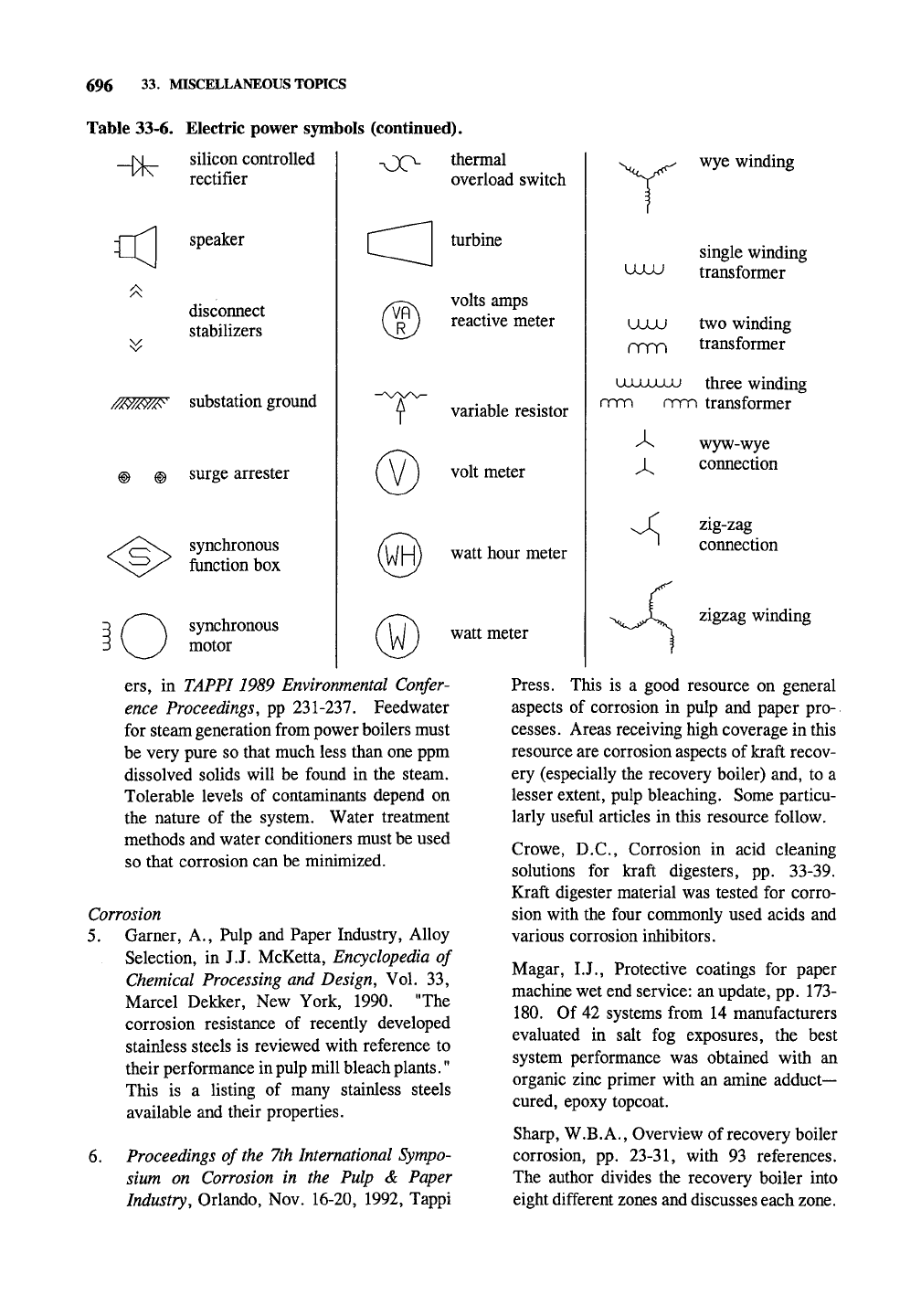
696 33. MISCELLANEOUS TOPICS
Table 33-6. Electric power symbols (continued).
-Wr
^
silicon controlled I OO" thermal
rectifier overload switch
speaker
disconnect I /^^/fl^
stabilizers | \JRy
/M^W^ substation ground
synchronous
function box
synchronous
motor
turbine
volts amps
reactive meter
variable resistor
@ surge arrester ( V ) ^^^^ meter
WH
watt hour meter
watt meter
T
uuuu
wye winding
single winding
transformer
uuuu two winding
crrc\ transformer
u-LLUJjj three winding
nmn nnm transformer
wyw-wye
JL^
connection
•^
zig-zag
connection
zigzag winding
ers,
in TAPPI1989 Environmental Confer-
ence Proceedings, pp 231-237. Feedwater
for steam generation from power boilers must
be very pure so that much less than one ppm
dissolved solids will be found in the steam.
Tolerable levels of contaminants depend on
the nature of the system. Water treatment
methods and water conditioners must be used
so that corrosion can be minimized.
Corrosion
5.
Garner, A., Pulp and Paper Industry, Alloy
Selection, in J.J. McKetta, Encyclopedia of
Chemical Processing and Design, Vol. 33,
Marcel Dekker, New York, 1990. "The
corrosion resistance of recently developed
stainless steels is reviewed with reference to
their performance in pulp mill bleach plants."
This is a listing of many stainless steels
available and their properties.
6. Proceedings of the 7th International Sympo-
sium on Corrosion in the Pulp & Paper
Industry, Orlando, Nov. 16-20, 1992, Tappi
Press.
This is a good resource on general
aspects of corrosion in pulp and paper pro-
cesses. Areas receiving high coverage in this
resource are corrosion aspects of kraft recov-
ery (especially the recovery boiler) and, to a
lesser extent, pulp bleaching. Some particu-
larly useful articles in this resource follow.
Crowe, D.C., Corrosion in acid cleaning
solutions for kraft digesters, pp. 33-39.
Kraft digester material was tested for corro-
sion with the four commonly used acids and
various corrosion inhibitors.
Magar, I.J., Protective coatings for paper
machine wet end service: an update, pp. 173-
180.
Of 42 systems from 14 manufacturers
evaluated in salt fog exposures, the best
system performance was obtained with an
organic zinc primer with an amine adduct—
cured, epoxy topcoat.
Sharp, W.B.A., Overview of recovery boiler
corrosion, pp.
23-31,
with 93 references.
The author divides the recovery boiler into
eight different zones and discusses each zone.
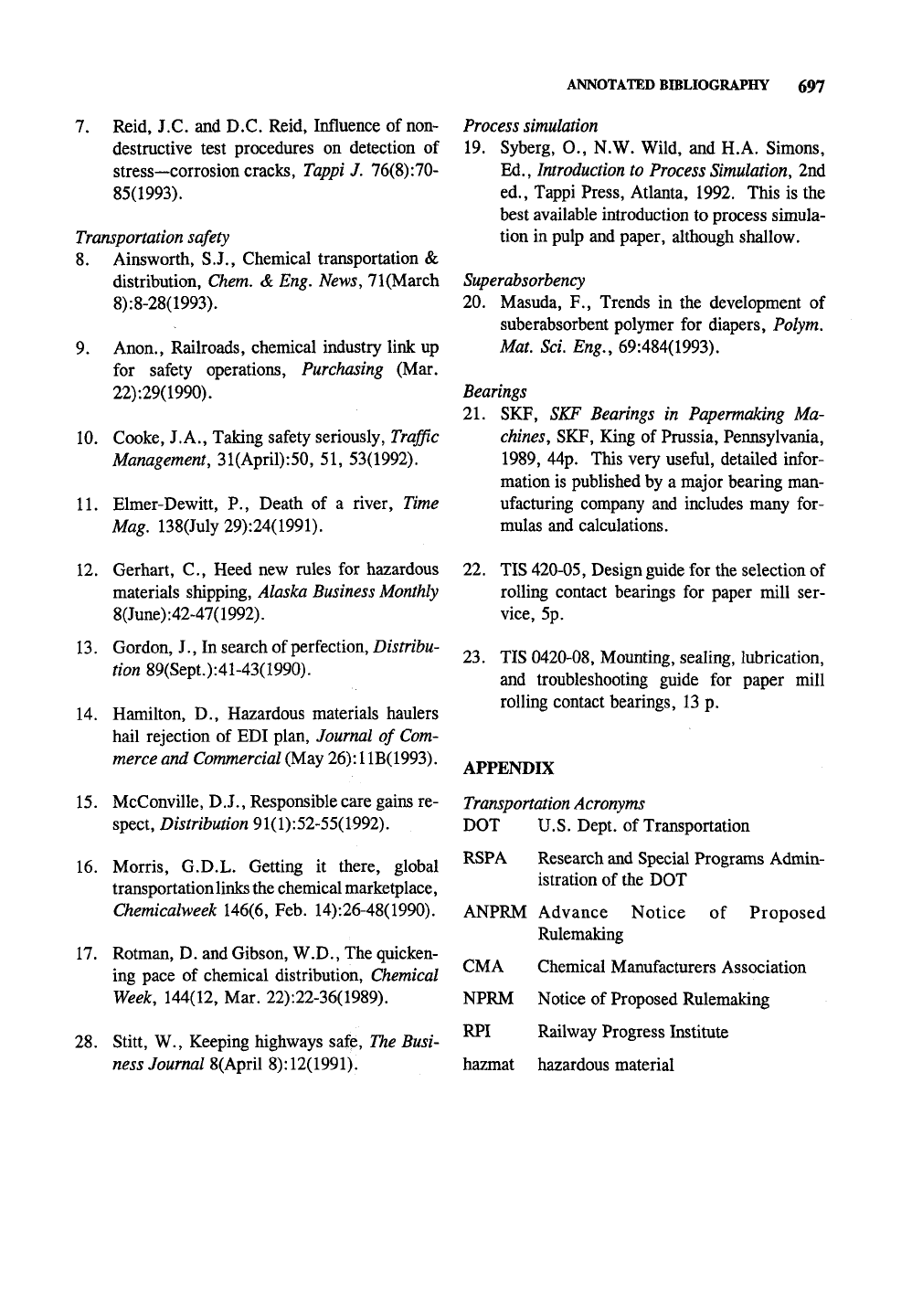
ANNOTATED BffiLIOGRAPHY 697
7.
Reid, J.C. and D.C. Reid, Influence of non-
destructive test procedures on detection of
stress—corrosion cracks, Tappi J. 76(8):70-
85(1993).
Transportation
safety
8. Ainsworth, S.J., Chemical transportation &
distribution, Chem. & Eng. News, 71 (March
8):8-28(1993).
9. Anon., Railroads, chemical industry link up
for safety operations, Purchasing (Mar.
22):29(1990).
10.
Cooke, J.A., Taking safety seriously. Traffic
Management, 31(April):50, 51, 53(1992).
11.
Elmer-Dewitt, P., Death of a river. Time
Mag. 138(July29):24(1991).
12.
Gerhart, C, Heed new rules for hazardous
materials shipping, Alaska Business Monthly
8(June):42-47(1992).
13.
Gordon, J., In search of perfection. Distribu-
tion 89(Sept.):41-43(1990).
14.
Hamilton, D., Hazardous materials haulers
hail rejection of EDI plan. Journal of Com-
merce and
Commercial
(May
26):
11B(1993).
15.
McConville, D.J., Responsible care gains re-
spect. Distribution 91(1):52-55(1992).
16.
Morris, G.D.L. Getting it there, global
transportation
links the
chemical marketplace,
Chemicalweek 146(6, Feb. 14):26-48(1990).
17.
Rotman, D. and Gibson, W.D., The quicken-
ing pace of chemical distribution. Chemical
Week,
144(12, Mar. 22):22-36(1989).
28.
Stitt, W., Keeping highways safe, The Busi-
ness Journal 8(April
8):
12(1991).
Process
simulation
19.
Syberg, O., N.W. Wild, and H.A. Simons,
Ed.,
Introduction
to Process Simulation, 2nd
ed., Tappi Press, Atlanta, 1992. This is the
best available introduction to process simula-
tion in pulp and paper, although shallow.
Superabsorbency
20.
Masuda, P., Trends in the development of
suberabsorbent polymer for diapers, Polym.
Mat. Sci. Eng., 69:484(1993).
Bearings
21.
SKF, SKF Bearings in Papermaking Ma-
chines, SKF, King of Prussia, Pennsylvania,
1989,
44p. This very useful, detailed infor-
mation is published by a major bearing man-
ufacturing company and includes many for-
mulas and calculations.
22.
TIS 420-05, Design guide for the selection of
rolling contact bearings for paper mill ser-
vice,
5p.
23.
TIS 0420-08, Mounting, sealing, lubrication,
and troubleshooting guide for paper mill
rolling contact bearings, 13 p.
APPENDIX
Transportation
Acronyms
DOT U.S. Dept. of Transportation
RSPA Research and Special Programs Admin-
istration of the DOT
ANPRM Advance Notice of Proposed
Rulemaking
CMA Chemical Manufacturers Association
NPRM Notice of Proposed Rulemaking
RPI Railway Progress Institute
hazmat hazardous material
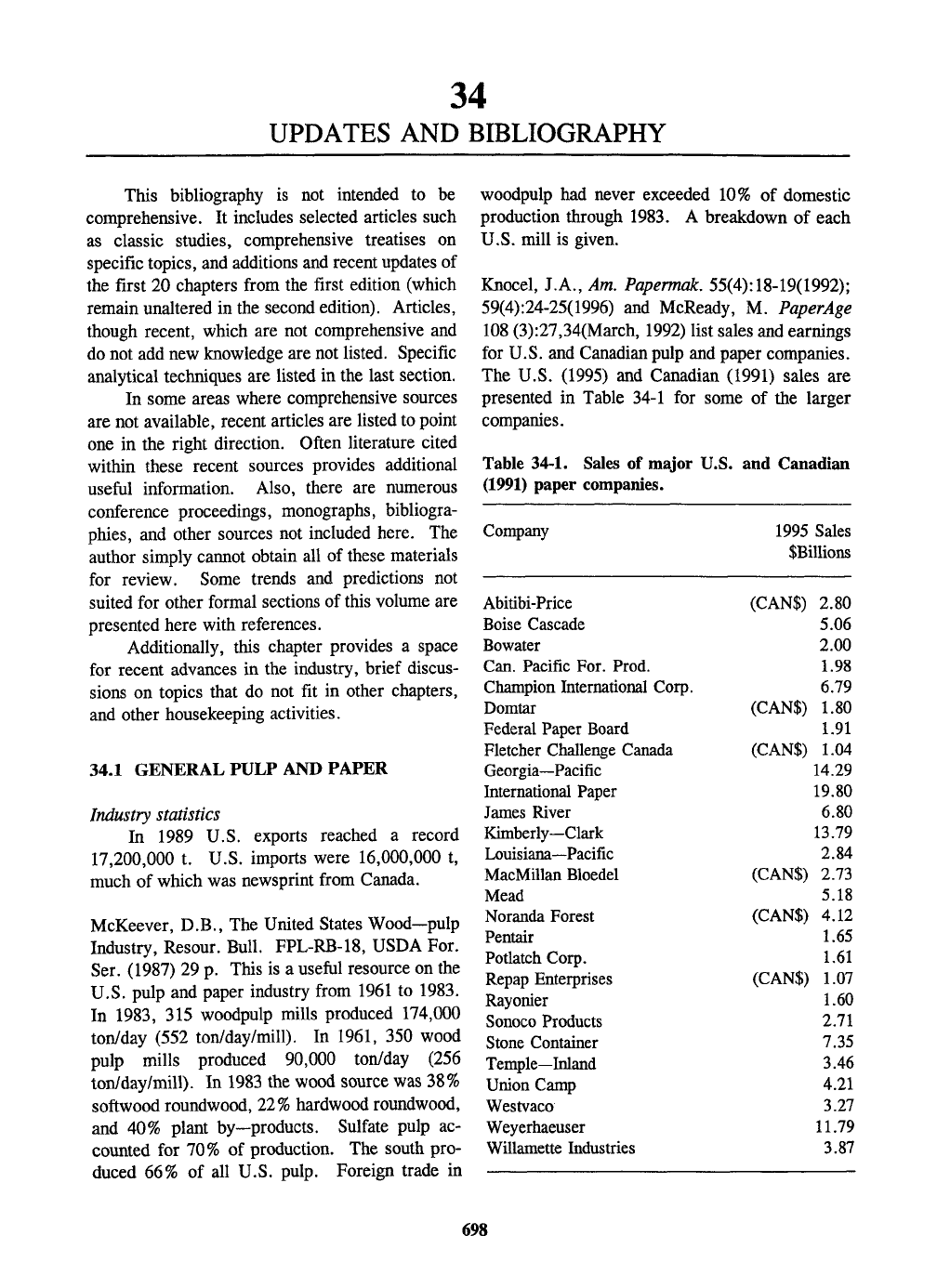
34
UPDATES AND BIBLIOGRAPHY
This bibliography is not intended to be
comprehensive. It includes selected articles such
as classic studies, comprehensive treatises on
specific topics, and additions and recent updates of
the first 20 chapters from the first edition (which
remain unaltered in the second edition). Articles,
though recent, which are not comprehensive and
do not add new knowledge are not listed. Specific
analytical techniques are listed in the last section.
In some areas where comprehensive sources
are not available, recent articles are listed to point
one in the right direction. Often literature cited
within these recent sources provides additional
useful information. Also, there are numerous
conference proceedings, monographs, bibliogra-
phies,
and other sources not included here. The
author simply cannot obtain all of these materials
for review. Some trends and predictions not
suited for other formal sections of this volimie are
presented here with references.
Additionally, this chapter provides a space
for recent advances in the industry, brief discus-
sions on topics that do not fit in other chapters,
and other housekeeping activities.
34.1 GENERAL PULP AND PAPER
Industry statistics
In 1989 U.S. exports reached a record
17,200,000 t. U.S. imports were 16,000,000 t,
much of which was newsprint from Canada.
McKeever, D.B., The United States Wood—pulp
Industry, Resour. Bull. FPL-RB-18, USDA For.
Ser. (1987) 29 p. This is a useful resource on the
U.S.
pulp and paper industry from 1961 to 1983.
In 1983, 315 woodpulp mills produced 174,000
ton/day (552 ton/day/mill). In 1961, 350 wood
pulp mills produced 90,000 ton/day (256
ton/day/mill). In 1983 the wood source was 38%
softwood roundwood, 22% hardwood roundwood,
and 40% plant by—products. Sulfate pulp ac-
counted for 70% of production. The south pro-
duced 66% of all U.S. pulp. Foreign trade in
woodpulp had never exceeded 10% of domestic
production through 1983. A breakdown of each
U.S.
mill is given.
Knocel, J.A., Am, Papermak,
55(4):
18-19(1992);
59(4):24-25(1996) and McReady, M. PaperAge
108 (3):27,34(March, 1992) list sales and earnings
for U.S. and Canadian pulp and paper companies.
The U.S. (1995) and Canadian (1991) sales are
presented in Table 34-1 for some of the larger
companies.
Table 34-1. Sales of major U.S. and Canadian
(1991) paper companies.
Company
Abitibi-Price
Boise Cascade
Bowater
Can. Pacific For. Prod.
Champion International Corp.
Domtar
Federal Paper Board
Fletcher Challenge Canada
Georgia—Pacific
International Paper
James River
Kimberly-Clark
Louisiana—Pacific
MacMillan Bloedel
Mead
Noranda Forest
Pentair
Potlatch Corp.
Repap Enterprises
Rayonier
Sonoco Products
Stone Container
Temple—Inland
Union Camp
Westvaco
Weyerhaeuser
Willamette Industries
1995 Sales
$Billions
(CAN$) 2.80
5.06
2.00
1.98
6.79
(CAN$) 1.80
1.91
(CAN$) 1.04
14.29
19.80
6.80
13.79
2.84
(CAN$) 2.73
5.18
(CAN$) 4.12
1.65
1.61
(CAN$) 1.07
1.60
2.71
7.35
3.46
4.21
3.27
11.79
3.87
698

GENERAL PULP AND PAPER 699
Pulp manufacturing costs
Fromson, D.A., One and only chance, Paper-
maker 57(11):39, 41, 42(1994). This article gives
a breakdown (fiber, chemicals, energy, labor,
materials) of costs for pulp manufacture in six
countries. Softwood pulp manufacturing costs
totaled $276 (USD) in Chile, $328 in the south-
eastern U.S., $361 in Canada, $422 in New
Zealand and Nordic, $444 in the western U.S.,
and $598 in Japan. Hardwood pulp manufacturing
costs ranged from $217—488; newsprint manufac-
turing ranged from $269—$577.
Chemical usage
Ferguson, K.H., Chemical markets remain stable
as industry activity levels off. Pulp & Paper
70(3):79, 80, 85(Mar., 1996). In 1996, the
annual U.S. consumption of chemicals in the paper
industry is estimated at 557,000 ton of alum at
$120 per ton, 1.2 million tons of calcium carbon-
ate at $100—$200 per ton, 3.5 to 3.8 million tons
of kaolin clay at $32—$65 per ton for filler grades
to more than $160 per ton for the premium coating
grades, 4 to 4.5 million pounds (seems very low)
of modified starch at $0.13—$0.29 per pound (up
to $0.50 per pound for some grades), 1.4 billion
pounds of styrene—butadiene latex for coating
binders at $0.60—$0.70 per pound, and 250,000
tons of titanium dioxide at $0.85—$1.00 per
pound. Other wet—end additives are discussed.
Piccone, J., Prices to increase as demand catches
up with supplies. Pulp Paper Can.
96(1):
18,
19,
22(1995). This is a good analysis of the availabil-
ity and use of chemical raw materials by the
Canadian pulp and paper industry. It shows some
trends: in 1993 this industry used 195,000 t of
CI2,
but in 1994 it was only 157,000 t.
34.2 WOOD
Wood procurement
Slinn, R.J., The impact of industry restructuring
on fiber procurement, J. Forestry (2)17-20(1989).
"The past and present roles of the pulp and paper
sector in wood procurement."
Wood handling
Piggott, H.R. and R.A. Thompson, Drum bark-
ing: key factors for design and performance, Tappi
J. 70(8):37-41(1987). No references.
Wood physics and transport properties
Woods like redwood that have a high level of
water—soluble extractives have a low apparent
value for the FSP; it is believed that these
extractives use some of the sites that water nor-
mally uses. Perhaps this effect is observed in
paper with certain water—soluble materials (like
polymers). On the other hand, hemicellulose has
a high FSP so starch might increase the FSP of
paper. Pulps generally have a slightly lower FSP
than the woods from which they were derived.
Cellulose molecules have an index of refrac-
tion of 1.599 in the axial direction and 1.532 in
the transverse direction. The dielectric constant is
5.7 and the breakdown voltage is 500 kV/cm.
Dunlop, F., U. S. Dept. Ag. Bull. 110 (1912).
The specific heat of wood as 0.266 at 0°C and
0.382 at 100°C for wood with 0% moisture.
A correction for specific heat at 0% mois-
ture,
c^, is calculated from the fractional moisture
content of wood, m, and the specific heat due to
wood—water bound energy, A, as follows:
Specific heat = A + (m + c^l{\ + m)
where at 0.10 water content A varies from 0.02 at
85°F to 0.04 at 140°F and at 0.30 water content
A varies from 0.04 to 0.09 for 85—140°F.
Huang, C—L., Revealing the fibril angle in wood
sections by ultrasonic treatment. Wood and Fiber
Sci. 27(1):49-54(1995).
James, W.L, Y.-H.Yen, and R.J. King, A
microwave method for measuring moisture con-
tent, density, and grain angle of wood, USDA,
For. Ser. Res. Note FPL-0250 (1985), 9 p. The
attenuation, phase shift, and depolarization of a
polarized 4.81 GHz wave transmitted through a
wood specimen can provide estimates of the
moisture content, density, and grain angle of the
specimen.
Jimenez, G, W.T. McKean, and R.R. Gustafson,
Using a kraft pulping model to improve pulp
uniformity, Tappi J. 73(7)173-176(1990). This
article covers diffusion of solutions at high pH
(12—14),
such as in kraft pulping, where swelling
of wood increases the diffusion in the radial and
tangential directions to that approaching the longi-
tudinal direction.
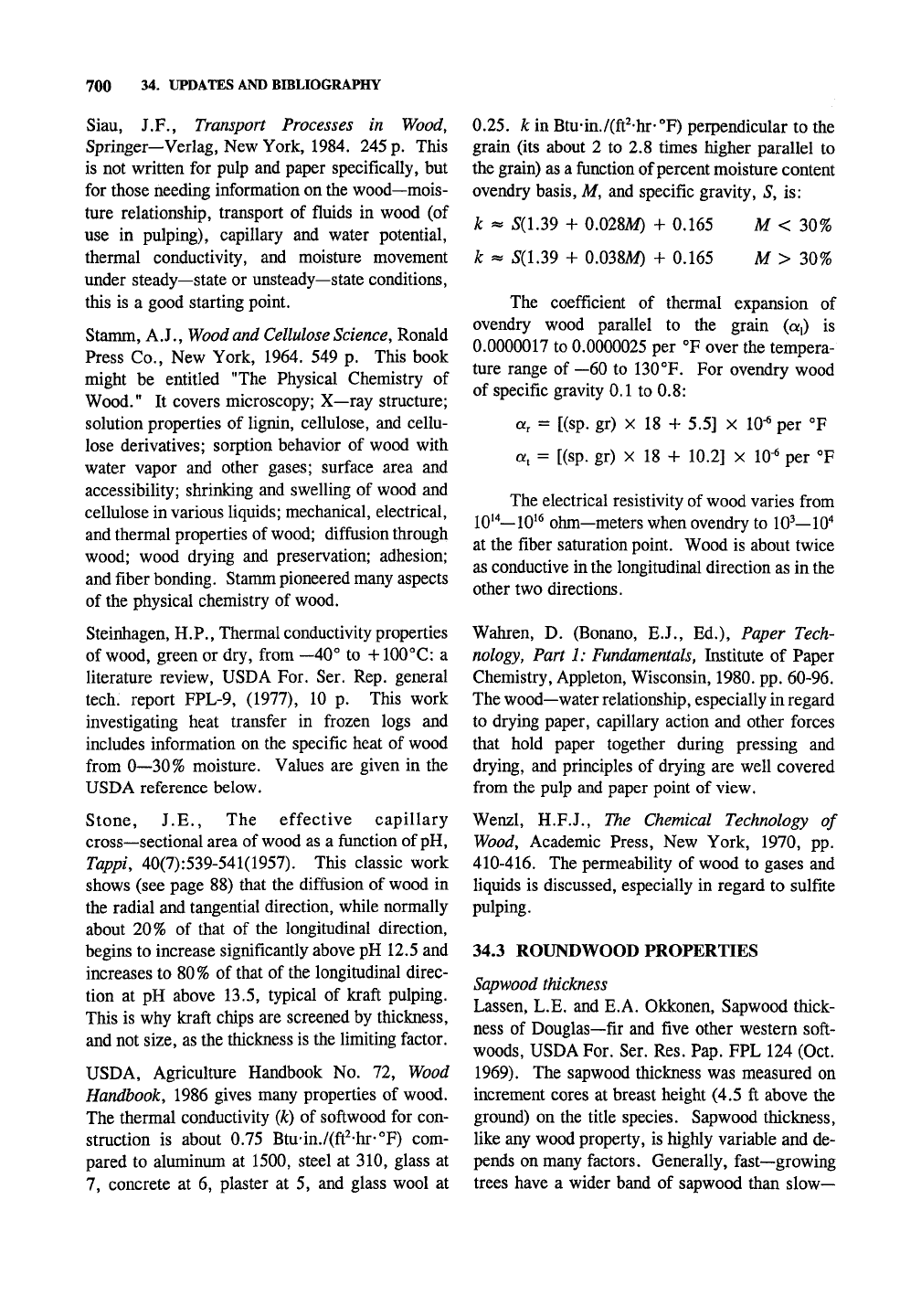
700 34. UPDATES AND BIBLIOGRAPHY
Siau, J.F., Transport Processes in
Wood,
Springer—Verlag, New York, 1984. 245 p. This
is not written for pulp and paper specifically, but
for those needing information on the wood—mois-
ture relationship, transport of fluids in wood (of
use in pulping), capillary and water potential,
thermal conductivity, and moisture movement
under steady—state or unsteady—state conditions,
this is a good starting point.
Stamm, A.J.,
Wood
and
Cellulose
Science,
Ronald
Press Co., New York, 1964. 549 p. This book
might be entitled "The Physical Chemistry of
Wood." It covers microscopy; X—ray structure;
solution properties of lignin, cellulose, and cellu-
lose derivatives; sorption behavior of wood with
water vapor and other gases; surface area and
accessibility; shrinking and swelling of wood and
cellulose in various liquids; mechanical, electrical,
and thermal properties of
wood;
diffusion through
wood; wood drying and preservation; adhesion;
and fiber bonding. Stamm pioneered many aspects
of the physical chemistry of wood.
Steinhagen, H.P., Thermal conductivity properties
of wood, green or dry, from —40° to +100°C: a
literature review, USDA For. Ser. Rep. general
tech. report FPL-9, (1977), 10 p. This work
investigating heat transfer in frozen logs and
includes information on the specific heat of wood
from 0—30% moisture. Values are given in the
USDA reference below.
Stone, J.E., The effective capillary
cross—sectional area of wood as a function of
pH,
Tappi, 40(7):539-541(1957). This classic work
shows (see page 88) that the diffusion of wood in
the radial and tangential direction, while normally
about 20% of that of the longitudinal direction,
begins to increase significantly above pH 12.5 and
increases to 80% of that of the longitudinal direc-
tion at pH above 13.5, typical of kraft pulping.
This is why kraft chips are screened by thickness,
and not size, as the thickness is the limiting factor.
USDA, Agriculture Handbook No. 72, Wood
Handbook, 1986 gives many properties of wood.
The thermal conductivity
{k)
of softwood for con-
struction is about 0.75 Btu-in./(ft^-hr-°F) com-
pared to aluminum at 1500, steel at 310, glass at
7,
concrete at 6, plaster at 5, and glass wool at
0.25.
k in Btu-in./(ft2-hr' °F) perpendicular to the
grain (its about 2 to 2.8 times higher parallel to
the grain) as a
ftmction
of percent moisture content
ovendry basis, M, and specific gravity, S, is:
k « ^(1.39 + 0.028M) + 0.165 M <
2>Q7o
k « 5(1.39 + 0.038M) + 0.165 M > 30%
The coefficient of thermal expansion of
ovendry wood parallel to the grain (a^) is
0.0000017 to 0.0000025 per °F over the tempera-
ture range of —60 to 130°F. For ovendry wood
of specific gravity 0.1 to 0.8:
«r = [(sp. gr) X 18 + 5.5] X
10"^
per °F
«t = [(sp. gr) X 18 + 10.2] X
10-^
per °F
The electrical resistivity of wood varies from
10i4_io^6 ohm—meters when ovendry to 10^—10"^
at the fiber saturation point. Wood is about twice
as conductive in the longitudinal direction as in the
other two directions.
Wahren, D. (Bonano, E.J., Ed.), Paper Tech-
nology, Part 1:
Fundamentals,
Institute of Paper
Chemistry, Appleton, Wisconsin, 1980. pp. 60-96.
The wood—water relationship, especially in regard
to drying paper, capillary action and other forces
that hold paper together during pressing and
drying, and principles of drying are well covered
from the pulp and paper point of view.
Wenzl, H.F.J., The Chemical Technology of
Wood,
Academic Press, New York, 1970, pp.
410-416. The permeability of wood to gases and
liquids is discussed, especially in regard to sulfite
pulping.
34.3 ROUNDWOOD PROPERTIES
Sapwood thickness
Lassen, L.E. and E.A. Okkonen, Sapwood thick-
ness of Douglas—fir and five other western soft-
woods, USDA For. Ser. Res. Pap. FPL 124 (Oct.
1969).
The sapwood thickness was measured on
increment cores at breast height (4.5 ft above the
ground) on the title species. Sapwood thickness,
like any wood property, is highly variable and de-
pends on many factors. Generally, fast—growing
trees have a wider band of sapwood than slow—
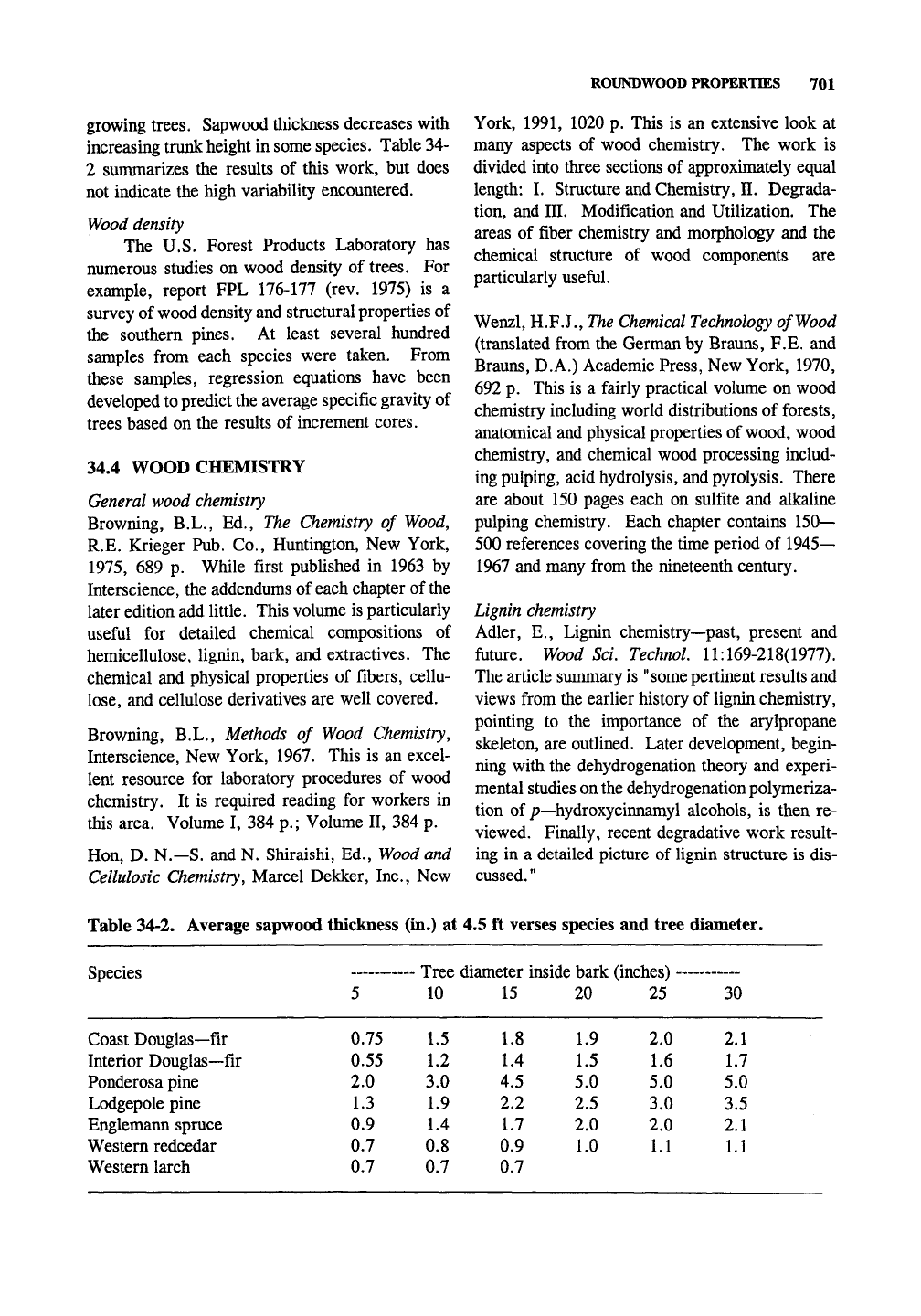
ROUNDWOOD PROPERTIES 701
growing trees. Sapwood thickness decreases with
increasing trunk height in some species. Table 34-
2 summarizes the results of this work, but does
not indicate the high variability encountered.
Wood density
The U.S. Forest Products Laboratory has
numerous studies on wood density of trees. For
example, report FPL 176-177 (rev. 1975) is a
survey of wood density and structural properties of
the southern pines. At least several hundred
samples from each species were taken. From
these samples, regression equations have been
developed to predict the average specific gravity of
trees based on the results of increment cores.
34.4 WOOD CHEMISTRY
General wood chemistry
Browning, B.L., Ed., The Chemistry of
Wood,
R.E. Krieger Pub. Co., Huntington, New York,
1975,
689 p. While first published in 1963 by
Interscience, the addendums of each chapter of the
later edition add little. This volume is particularly
useful for detailed chemical compositions of
hemicellulose, lignin, bark, and extractives. The
chemical and physical properties of fibers, cellu-
lose,
and cellulose derivatives are well covered.
Browning, B.L., Methods of Wood Chemistry,
Interscience, New York, 1967. This is an excel-
lent resource for laboratory procedures of wood
chemistry. It is required reading for workers in
this area. Volume I, 384 p.; Volume II, 384 p.
Hon, D. N.—S. and N. Shiraishi, Ed., Wood and
Cellulosic Chemistry, Marcel Dekker, Inc., New
York, 1991, 1020 p. This is an extensive look at
many aspects of wood chemistry. The work is
divided into three sections of approximately equal
length: I. Structure and Chemistry, II. Degrada-
tion, and in. Modification and Utilization. The
areas of fiber chemistry and morphology and the
chemical structure of wood components are
particularly useful.
Wenzl, H.F.J., The
Chemical Technology
of Wood
(translated from the German by Brauns, F.E. and
Brauns, D.A.) Academic Press, New York, 1970,
692 p. This is a fairly practical volume on wood
chemistry including world distributions of forests,
anatomical and physical properties of wood, wood
chemistry, and chemical wood processing includ-
ing pulping, acid hydrolysis, and pyrolysis. There
are about 150 pages each on sulfite and alkaline
pulping chemistry. Each chapter contains 150—
500 references covering the time period of 1945—
1967 and many from the nineteenth century.
Lignin chemistry
Adler, E., Lignin chemistry—past, present and
future. Wood Sci. Technol. 11:169-218(1977).
The article summary is "some pertinent results and
views from the earlier history of lignin chemistry,
pointing to the importance of the arylpropane
skeleton, are outlined. Later development, begin-
ning with the dehydrogenation theory and experi-
mental studies on the dehydrogenation polymeriza-
tion of p—hydroxycinnamyl alcohols, is then re-
viewed. Finally, recent degradative work result-
ing in a detailed picture of lignin structure is dis-
cussed."
Table 34-2. Average sapwood thickness (in.) at 4.5 ft verses species and tree diameter.
Species
Coast Douglas—fir
Interior Douglas—fir
Ponderosa pine
Lodgepole pine
Englemann spruce
Western redcedar
Western larch
5
0.75
0.55
2.0
1.3
0.9
0.7
0.7
- Tree diameter inside bark (i
10
1.5
1.2
3.0
1.9
1.4
0.8
0.7
15
1.8
1.4
4.5
2.2
1.7
0.9
0.7
20
1.9
1.5
5.0
2.5
2.0
1.0
ildlCoy
25
2.0
1.6
5.0
3.0
2.0
1.1
30
2.1
1.7
5.0
3.5
2.1
1.1
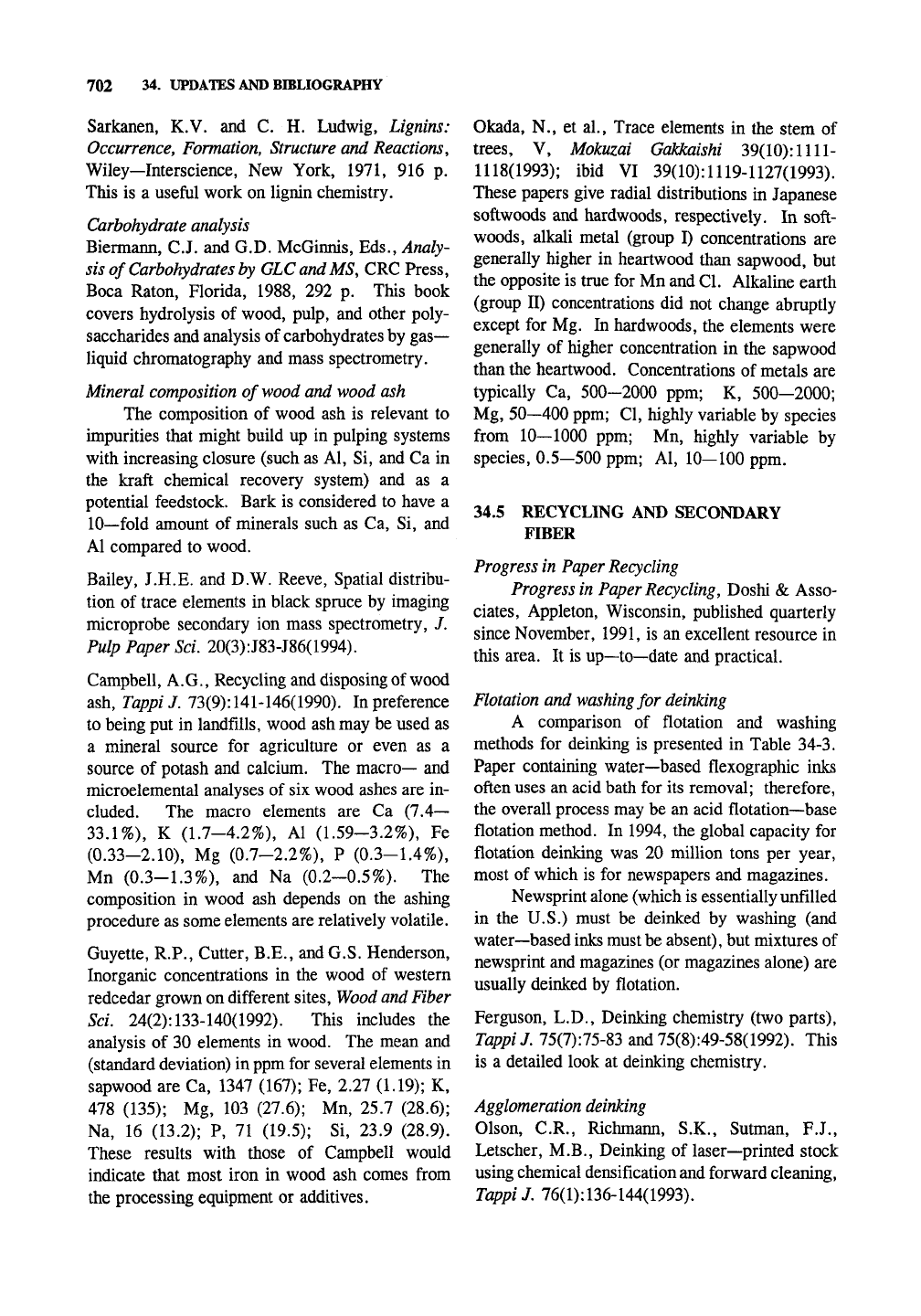
702 34. UPDATES AND BffiLIOGRAPHY
Sarkanen, K.V. and C. H. Ludwig, Lignins:
Occurrence, Formation, Structure and Reactions,
Wiley—Interscience, New York, 1971, 916 p.
This is a useful work on lignin chemistry.
Carbohydrate
analysis
Bieraiann, CJ. and G.D. McGinnis, Eds., Analy-
sis of
Carbohydrates
by
GLC and
MS, CRC Press,
Boca Raton, Florida, 1988, 292 p. This book
covers hydrolysis of wood, pulp, and other poly-
saccharides and analysis of carbohydrates by gas-
liquid chromatography and mass spectrometry.
Mineral composition of
wood
and wood ash
The composition of wood ash is relevant to
impurities that might build up in pulping systems
with increasing closure (such as Al, Si, and Ca in
the kraft chemical recovery system) and as a
potential feedstock. Bark is considered to have a
10—fold amount of minerals such as Ca, Si, and
Al compared to wood.
Bailey, J.H.E. and D.W. Reeve, Spatial distribu-
tion of trace elements in black spruce by imaging
microprobe secondary ion mass spectrometry, /.
Pulp Paper
ScL
20(3):J83-J86(1994).
Campbell, A.G., Recycling and disposing of wood
ash,
TappiJ.
73(9):
141-146(1990). In preference
to being put in landfills, wood ash may be used as
a mineral source for agriculture or even as a
source of potash and calcium. The macro— and
microelemental analyses of six wood ashes are in-
cluded. The macro elements are Ca (7.4—
33.1%),
K (1.7-4.2%), Al (1.59-3.2%), Fe
(0.33-2.10), Mg (0.7-2.2%), P (0.3-1.4%),
Mn (0.3-1.3%), and Na (0.2-0.5%). The
composition in wood ash depends on the ashing
procedure as some elements are relatively volatile.
Guyette, R.P., Cutter, B.E., and G.S. Henderson,
Inorganic concentrations in the wood of western
redcedar grown on different sites.
Wood
and
Fiber
ScL
24(2):
133-140(1992).
This includes the
analysis of 30 elements in wood. The mean and
(standard deviation) in ppm for several elements in
sapwood are Ca, 1347 (167); Fe, 2.27 (1.19); K,
478 (135); Mg, 103 (27.6); Mn, 25.7 (28.6);
Na, 16 (13.2); P, 71 (19,5); Si, 23.9 (28.9).
These results with those of Campbell would
indicate that most iron in wood ash comes from
the processing equipment or additives.
Okada, N., et al.. Trace elements in the stem of
trees,
V, Mokuzai Gakkaishi 39(10):1111-
1118(1993); ibid VI
39(10):
1119-1127(1993).
These papers give radial distributions in Japanese
softwoods and hardwoods, respectively. In soft-
woods, alkali metal (group I) concentrations are
generally higher in heartwood than sapwood, but
the opposite is true for Mn and CI. Alkaline earth
(group II) concentrations did not change abruptly
except for Mg. In hardwoods, the elements were
generally of higher concentration in the sapwood
than the heartwood. Concentrations of metals are
typically Ca, 500-2000 ppm; K, 500—2000;
Mg, 50—400 ppm; CI, highly variable by species
from 10—1000 ppm; Mn, highly variable by
species, 0.5—500 ppm; Al, 10—100 ppm.
34.5 RECYCLING AND SECONDARY
FIBER
Progress in
Paper Recycling
Progress in
Paper
Recycling,
Doshi & Asso-
ciates,
Appleton, Wisconsin, published quarterly
since November, 1991, is an excellent resource in
this area. It is up—to—date and practical.
Flotation and washing for deinking
A comparison of flotation and washing
methods for deinking is presented in Table 34-3.
Paper containing water—based flexographic inks
often uses an acid bath for its removal; therefore,
the overall process may be an acid flotation—base
flotation method. In 1994, the global capacity for
flotation deinking was 20 million tons per year,
most of which is for newspapers and magazines.
Newsprint alone (which is essentially unfilled
in the U.S.) must be deinked by washing (and
water—based inks must be absent), but mixtures of
newsprint and magazines (or magazines alone) are
usually deinked by flotation.
Ferguson, L.D., Deinking chemistry (two parts),
TappiJ.
75(7):75-83 and75(8):49-58(1992). This
is a detailed look at deinking chemistry.
Agglomeration
deinking
Olson, C.R., Richmann, S.K., Sutman, F.J.,
Letscher, M.B., Deinking of laser—printed stock
using chemical densificationand forward cleaning,
TappiJ.
76(1):
136-144(1993).
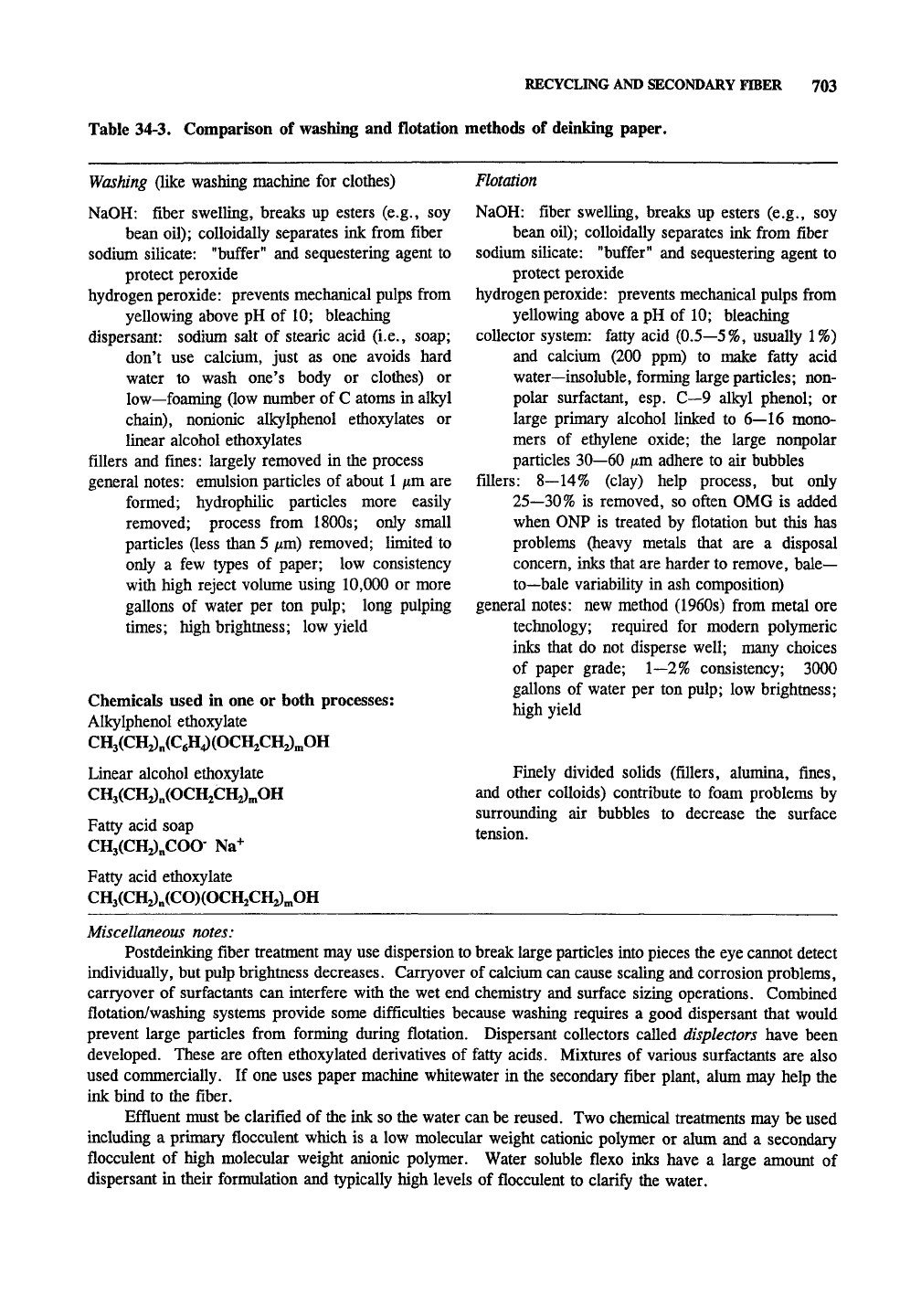
RECYCLING
AND
SECONDARY FIBER 703
Table 34-3. Comparison of washing and flotation methods of deinking paper.
Washing
(like washing machine for clothes)
NaOH: fiber swelling, breaks up esters (e.g., soy
bean oil); coUoidally separates ink from fiber
sodium silicate: "buffer" and sequestering agent to
protect peroxide
hydrogen
peroxide:
prevents mechanical pulps from
yellowing above pH of 10; bleaching
dispersant: sodium salt of stearic acid (i.e., soap;
don't use calcium, just as one avoids hard
water to wash one's body or clothes) or
low—foaming (low number of C atoms in alkyl
chain),
nonionic alkylphenol ethoxylates or
linear alcohol ethoxylates
fillers and fines: largely removed in the process
general notes: emulsion particles of about
1
^m are
formed; hydrophilic particles more easily
removed; process from 1800s; only small
particles (less than 5 fim) removed; limited to
only a few types of paper; low consistency
with high reject volume using 10,000 or more
gallons of water per ton pulp; long pulping
times;
high brightness; low yield
Chemicals used in one or both processes:
Alkylphenol ethoxylate
CH3(CH2)„(C,H4)(OCH2CH2)„OH
Linear alcohol ethoxylate
CH3(CH2)„(OCH,CH2),OH
Fatty acid soap
CH3(CH2)„COO- Na+
Fatty acid ethoxylate
CH3(CH2)„(CO)(OCH2CH2)„OH
Flotation
NaOH: fiber swelling, breaks up esters (e.g., soy
bean oil); coUoidally separates ink fi:om fiber
sodium silicate: "buffer" and sequestering agent to
protect peroxide
hydrogen
peroxide:
prevents mechanical pulps from
yellowing above a pH of 10; bleaching
collector system: fatty acid
(0.5—5%,
usually 1%)
and calcium (200 ppm) to make fatty acid
water—insoluble, forming large
particles;
non-
polar surfactant, esp. C—9 alkyl phenol; or
large primary alcohol linked to 6—16 mono-
mers of ethylene oxide; the large nonpolar
particles 30—60 /xm adhere to air bubbles
fillers: 8—14% (clay) help process, but only
25—30%
is removed, so often OMG is added
when ONP is treated by flotation but this has
problems (heavy metals that are a disposal
concern, inks that are harder to remove, bale—
to—bale variability in ash composition)
general notes: new method (1960s) from metal ore
technology; required for modern polymeric
inks that do not disperse well; many choices
of paper grade; 1—2% consistency; 3000
gallons of water per ton pulp; low brightness;
high yield
Finely divided solids (fillers, alumina, fines,
and other colloids) contribute to foam problems by
surrounding air bubbles to decrease the surface
tension.
Miscellaneous
notes:
Postdeinking fiber treatment may use dispersion to break large particles into pieces the eye cannot detect
individually, but pulp brightness decreases. Carryover of calcium can cause scaling and corrosion problems,
carryover of surfactants can interfere with the wet end chemistry and surface sizing operations. Combined
flotation/washing systems provide some difficulties because washing requires a good dispersant that would
prevent large particles from forming during flotation. Dispersant collectors called
displectors
have been
developed. These are often ethoxylated derivatives of fatty acids. Mixtures of various surfactants are also
used commercially. If one uses paper machine Whitewater in the secondary fiber plant, alum may help the
ink bind to the fiber.
Effluent must be clarified of the ink so the water can be reused. Two chemical treatments may be used
including a primary flocculent which is a low molecular weight cationic polymer or alum and a secondary
flocculent of high molecular weight anionic polymer. Water soluble flexo inks have a large amount of
dispersant m their formulation and typically high levels of
flocculent
to clarify the water.
